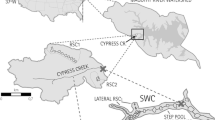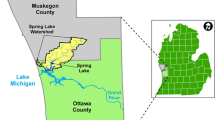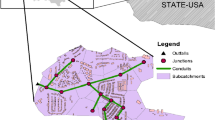Abstract
This paper describes the performance of a retrofitted stormwater retention pond (Ashby Pond) in Northern Virginia, USA. Retrofitting is a common practice which involves modifying existing structures and/or urban landscapes to improve water quality treatment, often compromising standards to meet budgetary and site constraints. Ashby Pond is located in a highly developed headwater watershed of the Potomac River and the Chesapeake Bay. A total maximum daily load (TMDL) was imposed on the Bay watershed by the US Environmental Protection Agency in 2010 due to excessive sediment and nutrient loadings leading to eutrophication of the estuary. As a result of the TMDL, reducing nutrient and sediment discharged loads has become the key objective of many stormwater programs in the Bay watershed. The Ashby Pond retrofit project included dredging of accumulated sediment to increase storage, construction of an outlet structure to control flows, and repairs to the dam. Due to space limitations, pond volume was less than ideal. Despite this shortcoming, Ashby Pond provided statistically significant reductions of phosphorus, nitrogen, and suspended sediments. Compared to the treatment credited to retention ponds built to current state standards, the retrofitted pond provided less phosphorus but more nitrogen reduction. Retrofitting the existing stock of ponds in a watershed to at least partially meet current design standards could be a straightforward way for communities to attain downstream water quality goals, as these improvements represent reductions in baseline loads, whereas new ponds in new urban developments simply limit future load increases or maintain the status quo.





Similar content being viewed by others
References
Alberti, M., Booth, D., Hill, K., Coburn, B., Avolio, C., Coe, S., et al. (2007). The impact of urban patterns on aquatic ecosystems: an empirical analysis in Puget lowland sub-basins. Landscape and Urban Planning, 80(4), 345–361. doi:10.1016/j.landurbplan.2006.08.001.
Allmendinger, N. E., Pizzuto, J. E., Moglen, G. E., & Lewicki, M. (2007). A sediment budget for an urbanizing watershed, 1951–1996, Montgomery County, Maryland, U.S.A. JAWRA Journal of the American Water Resources Association, 43(6), 1483–1498. doi:10.1111/j.1752-1688.2007.00122.x.
Barrett, M. (2008). Comparison of BMP performance using the international BMP database. Journal of Irrigation and Drainage Engineering, 134(5), 556–561. doi:10.1061/(ASCE)0733-9437(2008)134:5(556).
Beasley, G., & Kneale, P. (2002). Reviewing the impact of metals and PAHs on macroinvertebrates in urban watercourses. Progress in Physical Geography, 26(2), 236–270. doi:10.1191/0309133302pp334ra.
Bilotta, G. S., & Brazier, R. E. (2008). Understanding the influence of suspended solids on water quality and aquatic biota. Water Research, 42(12), 2849–2861. doi:10.1016/j.watres.2008.03.018.
Blecken, G.-T., Hunt, W. F., Al-Rubaei, A. M., Viklander, M., & Lord, W. G. (2017). Stormwater control measure (SCM) maintenance considerations to ensure designed functionality. Urban Water Journal, 14(3), 278–290. doi:10.1080/1573062X.2015.1111913.
Booth, D. B., & Jackson, C. R. (1997). Urbanization of aquatic systems: degradation thresholds, stormwater detection, and the limits of mitigation. JAWRA Journal of the American Water Resources Association, 33(5), 1077–1090. doi:10.1111/j.1752-1688.1997.tb04126.x.
Booth, D. B., Hartley, D., & Jackson, R. (2002). Forest cover, impervious-surface area, and the mitigation of stormwater impacts. JAWRA Journal of the American Water Resources Association, 38(3), 835–845. doi:10.1111/j.1752-1688.2002.tb01000.x.
Brater, E., & King, H. (1976). Handbook of hydraulics, for the solution of hydraulic engineering problems (6th ed.). New York: McGraw-Hill, Inc..
Camponelli, K. M., Lev, S. M., Snodgrass, J. W., Landa, E. R., & Casey, R. E. (2010). Chemical fractionation of Cu and Zn in stormwater, roadway dust and stormwater pond sediments. Environmental Pollution, 158(6), 2143–2149. doi:10.1016/j.envpol.2010.02.024.
Carey, R. O., Hochmuth, G. J., Martinez, C. J., Boyer, T. H., Dukes, M. D., Toor, G. S., et al. (2013). Evaluating nutrient impacts in urban watersheds: challenges and research opportunities. Environmental Pollution, 173, 138–149. doi:10.1016/j.envpol.2012.10.004.
Characklis, G., & Wiesner, M. (1997). Particles, metals, and water quality in runoff from large urban watershed. Journal of Environmental Engineering, 123(8), 753–759. doi:10.1061/(ASCE)0733-9372(1997)123:8(753).
Chesapeake Stormwater Network (CSN) (2011). CSN technical bulletin no. 9: nutrient accounting methods to document local stormwater load reductions in the Chesapeake Bay watershed.
Chin, A. (2006). Urban transformation of river landscapes in a global context. Geomorphology, 79(3–4), 460–487. doi:10.1016/j.geomorph.2006.06.033.
Chretien, F., Gagnon, P., Theriault, G., & Guillou, M. (2016). Performance analysis of a wet-retention pond in a small agricultural catchment. [Article]. Journal of Environmental Engineering, 142(4), 10. doi:10.1061/(asce)ee.1943-7870.0001081.
Cianfrani, C. M., Hession, W. C., & Rizzo, D. M. (2006). Watershed imperviousness impacts on stream channel condition in southeastern Pennsylvania. Journal of the American Water Resources Association, 42(4), 941–956. doi:10.1111/j.1752-1688.2006.tb04506.x.
Crunkilton, R., Kleist, J., Ramcheck, J., DeVita, W., & Villeneuve, D. (1996). Assessment of the response of aquatic organisms to long-term in situ exposures of urban runoff. In L. A. Roesner (Ed.), Effects of watershed development and management on aquatic ecosystems. American Society of Civil Engineers: New York.
Dietz, M. E., & Clausen, J. C. (2008). Stormwater runoff and export changes with development in a traditional and low impact subdivision. Journal of Environmental Management, 87(4), 560–566. doi:10.1016/j.jenvman.2007.03.026.
Dong, W., Li, H. E., & Li, J. K. (2013). Monitoring and analysis on evolution process of rainfall runoff water quality in urban area. Environmental Science, 34(2), 561–569.
Dorman, M. E., Hartigan, J. P., Steg, R. F., & Quasebarth, T. F. (1996). Retention, detention and overland flow for pollutant removal from highway stormwater runoff, Vol. 1: Research Report. Federal Highway Administration Report (pp. 166).
Easton, Z. M., & Petrovic, A. M. (2008a). Determining nitrogen loading rates based on land use in an urban watershed. In The Fate of Nutrients and Pesticides in the Urban Environment (Vol. 997, pp. 19–42, ACS Symposium Series, Vol. 997). American Chemical Society.
Easton, Z. M., & Petrovic, A. M. (2008b). Determining phosphorus loading rates based on land use in an urban watershed. In The Fate of Nutrients and Pesticides in the Urban Environment (Vol. 997, pp. 43–62, ACS Symposium Series, Vol. 997). American Chemical Society.
Edwards, A. C., & Withers, P. J. A. (2008). Transport and delivery of suspended solids, nitrogen and phosphorus from various sources to freshwaters in the UK. Journal of Hydrology, 350(3–4), 144–153. doi:10.1016/j.jhydrol.2007.10.053.
Erickson, A. J., Weiss, P. T., & Gulliver, J. S. (2013). Optimizing stormwater treatment practices. Springer Science & Business Media, 2, 13–15.
Feld, C. K., Birk, S., Bradley, D. C., Hering, D., Kail, J., Marzin, A., et al. (2011). Chapter three—from natural to degraded rivers and back again: a test of restoration ecology theory and practice. In W. Guy (Ed.), Advances in Ecological Research (Vol. Volume 44, pp. 119–209): Academic Press.
Fitch, E. B. (1958). Detention time concepts. Sewage and Industrial Wastes, 30(11), 1361–1363. doi:10.2307/25033740.
Fletcher, T. D., Andrieu, H., & Hamel, P. (2013). Understanding, management and modelling of urban hydrology and its consequences for receiving waters: a state of the art. Advances in Water Resources, 51, 261–279. doi:10.1016/j.advwatres.2012.09.001.
Fong, D. Y. T., Kwan, C. W., Lam, K. F., & Lam, K. S. L. (2003). Use of the sign test for the median in the presence of ties. American Statistician, 57(4), 237–240.
Galli, J. (1990). Thermal impacts associated with urbanization and urban stormwater management practices. (pp. 198). Washington, DC: Metropolitan Washington Council of Governments.
GC, & WWE. (2009). Urban stormwater BMP performance monitoring. Washington, DC: USEPA.
GC and WWE (2012a). BMP performance summary: Chesapeake Bay and related areas. International Stormwater BMP Database.
GC and WWE (2012b). International stormwater best management practices (BMP) database pollutant category summary: statistical addendum: TSS, bacteria, nutrients, and metals.
Grizzard, T. J., Randall, C. W., & Ellis, K. (1986). Effectiveness of extended detention ponds. In Engineering Foundation Conference on Urban Runoff – Impact and Quality Management Technology, Henniker, NH, 1986 (pp. 323–337)
Hancock, G. S., Holley, J. W., & Chambers, R. M. (2010). A field-based evaluation of wet retention ponds: how effective are ponds at water quantity control? JAWRA Journal of the American Water Resources Association, 46(6), 1145–1158. doi:10.1111/j.1752-1688.2010.00481.x.
Hartigan, J. P., Quasebarth, T. F., & Southerland, E. (1983). Calibration of NPS model loading factors. Journal of Environmental Engineering, 109(6), 1259–1272.
Hathaway, J. M., Hunt, W. F., & Simmons III, O. D. (2010). Statistical evaluation of factors affecting indicator bacteria in urban storm-water runoff. Journal of Environmental Engineering, 136(12), 1360–1368.
Helsel, D. R. (2012). Statistics for censored environmental data using Minitab and R. Hoboken: John Wiley and Sons.
Helsel, D. R., & Hirsch, R. M. (2002). Statistical methods in water resources, techniques of water resources investigations 04-A3. Techniques of water-resources investigations of the United States Geological Survey (Vol. 04-A3, p. 523). Reston: U.S. Geological Survey.
Herb, W. R., Janke, B., Mohseni, O., & Stefan, H. G. (2008). Thermal pollution of streams by runoff from paved surfaces. Hydrological Processes, 22(7), 987–999.
Hester, E. T., & Bauman, K. S. (2013). Stream and retention pond thermal response to heated summer runoff from urban impervious surfaces. Journal of the American Water Resources Association, 49(2), 328–342. doi:10.1111/jawr.12019.
Hewlett, J. D., & Fortson, J. C. (1982). Stream temperature under an inadequate buffer strip in the southeast Piedmont. JAWRA Journal of the American Water Resources Association, 18(6), 983–988. doi:10.1111/j.1752-1688.1982.tb00105.x.
Hogan, D. M., & Walbridge, M. R. (2007). Best management practices for nutrient and sediment retention in urban stormwater runoff. Journal of Environmental Quality, 36(2), 386–395. doi:10.2134/jeq2006.0142.
Jacobson, C. R. (2011). Identification and quantification of the hydrological impacts of imperviousness in urban catchments: a review. Journal of Environmental Management, 92(6), 1438–1448. doi:10.1016/j.jenvman.2011.01.018.
Jones, M. P., & Hunt, W. F. (2010). Effect of storm-water wetlands and wet ponds on runoff temperature in trout sensitive waters. [Article]. Journal of Irrigation and Drainage Engineering, 136(9), 656–661. doi:10.1061/(asce)ir.1943-4774.0000227.
Jones, M., Hunt, W., & Winston, R. (2012). Effect of urban catchment composition on runoff temperature. Journal of Environmental Engineering, 138(12), 1231–1236. doi:10.1061/(ASCE)EE.1943-7870.0000577.
Khan, S., Melville, B. W., & Shamseldin, A. Y. (2011). Retrofitting a stormwater retention pond using a deflector island. [Article]. Water Science & Technology, 63(12), 2867–2872. doi:10.2166/wst.2011.569.
Kumar, R., Martell, S. J., Pitcher, T. J., & Varkey, D. A. (2013). Temperature-driven decline of a Cisco population in Mille Lacs Lake, Minnesota. North American Journal of Fisheries Management, 33(4), 669–681. doi:10.1080/02755947.2013.785992.
Leopold, L. B. (1968). Hydrology for urban land planning: a guidebook on the hydrologic effects of urban land use. In United States Geological Survey (Ed.), Circular (pp. 18).
Line, D. E., & White, N. M. (2007). Effects of development on runoff and pollutant export. Water Environment Research, 79(2), 185–189.
Ma, J., Ying, G., & Sansalone, J. (2010). Transport and distribution of particulate matter phosphorus fractions in rainfall-runoff from roadway source areas. Journal of Environmental Engineering, 136(11), 1197–1205. doi:10.1061/ASCEEE.1943-7870.0000263.
Maxted, J. R., & Shaver, E. (1999) The use of retention basins to mitigate stormwater impacts to aquatic life. In National Conference on Retrofit Opportunities for Water Resource Protection in Urban Environments, Chicago, IL, EPA/625/R-99/002. USEPA, Cincinnatti, OH, (pp. 6–15).
Mejía, A. I., & Moglen, G. E. (2010). Impact of the spatial distribution of imperviousness on the hydrologic response of an urbanizing basin. Hydrological Processes, 24(23), 3359–3373. doi:10.1002/hyp.7755.
Merrikhpour, H., & Jalali, M. (2013). The effects of road salt application on the accumulation and speciation of cations and anions in an urban environment. Water and Environment Journal, 27(4), 524–534. doi:10.1111/j.1747-6593.2012.00371.x.
Minton, G. R. (2005). Stormwater management: biological, chemical and engineering principles (2nd ed.). Seattle: Resource Planning Associates.
Moglen, G. E., & Kim, S. (2007). Limiting imperviousness are threshold-based policies a good idea? Journal of the American Planning Association, 73(2), 161–171. doi:10.1080/01944360708976150.
Moore, T. L. C., & Hunt, W. F. (2012). Ecosystem service provision by stormwater wetlands and ponds—a means for evaluation? Water Research, 46(20), 6811–6823. doi:10.1016/j.watres.2011.11.026.
Navratil, O., Breil, P., Schmitt, L., Grospretre, L., & Albert, M. B. (2013). Hydrogeomorphic adjustments of stream channels disturbed by urban runoff (Yzeron River basin, France). Journal of Hydrology (Amsterdam), 485, 24–36. doi:10.1016/j.jhydrol.2012.01.036.
Nelson, E. J., & Booth, D. B. (2002). Sediment sources in an urbanizing, mixed land-use watershed. Journal of Hydrology, 264(1–4), 51–68. doi:10.1016/S0022-1694(02)00059-8.
Novotny, V., & Olem, H. (1994). Water quality: prevention, identification, and management of diffuse pollution. New York: Van Nostrand Reinhold.
OWML (2001). Quality assurance plan for the Occoquan Watershed Monitoring Laboratory. Manassas.
Parkin, T. B., & Robinson, J. B. (1993). Statistical evaluation of median estimators for lognormally distributed variables. Soil Science Society of America Journal, 57(2), 317–323.
Poff, N. L., Bledsoe, B. P., & Cuhaciyan, C. O. (2006). Hydrologic variation with land use across the contiguous United States: geomorphic and ecological consequences for stream ecosystems. Geomorphology, 79(3–4), 264–285. doi:10.1016/j.geomorph.2006.06.032.
Roseen, R. M., DiGennaro, N., Watts, A., Ballestero, T. P., & Houle, J. (2010) Preliminary results of the examination of thermal impacts from stormwater BMPs. In World Environ. Water Resour. Congress 2010: Challenges of Change, (pp. 16–20).
Sample, D. J., Grizzard, T. J., Sansalone, J., Davis, A. P., Roseen, R. M., & Walker, J. (2012). Assessing performance of manufactured treatment devices for the removal of phosphorus from urban stormwater. Journal of Environmental Management, 113, 279–291. doi:10.1016/j.jenvman.2012.08.039.
Schueler, T. R. (1994). The importance of imperviousness. Watershed protection techniques, 1(3), 100–111.
Schueler, T., Fraley-McNeal, L., & Cappiella, K. (2009). Is impervious cover still important? Review of recent research. Journal of Hydrologic Engineering, 14(4), 309–315. doi:10.1061/(ASCE)1084-0699(2009)14:4(309).
Shaver, E., & Horner, R. R. (2007). Fundamentals of urban runoff management: technical and institutional issues, 2nd edition. North American Lake Management Society.
Sønderup, M. J., Egemose, S., Bochdam, T., & Flindt, M. R. (2015a). Treatment efficiency of a wet detention pond combined with filters of crushed concrete and sand: a Danish full-scale study of stormwater. Environmental Monitoring and Assessment, 187(12), 758. doi:10.1007/s10661-015-4975-7.
Sønderup, M. J., Egemose, S., Hansen, A. S., Grudinina, A., Madsen, M. H., & Flindt, M. R. (2015b). Factors affecting retention of nutrients and organic matter in stormwater ponds. Ecohydrology.
Sonzogni, W. C., Chesters, G., Coote, D. R., Jeffs, D. N., Konrad, J. C., Ostry, R. C., et al. (1980). Pollution from land runoff. Environmental Science & Technology, 14(2), 148–153. doi:10.1021/es60162a003.
Strecker, E. W. (1998) Considerations and approaches for monitoring the effectiveness of urban BMPs. In National Conference on Retrofit Opportunity for Water Resources Protection in Urban Environments.
Thackston, E., Shields, F., & Schroeder, P. (1987). Residence time distributions of shallow basins. Journal of Environmental Engineering, 113(6), 1319–1332. doi:10.1061/(ASCE)0733-9372(1987)113:6(1319).
U.S. EPA. (1983a). Results of the nationwide urban runoff program. Washington, D.C.: US Environmental Protection Agency, Water Planning Division.
U.S. EPA. (1983b). Results of the nationwide urban runoff program: volume I—final report (Vol. 1, p. 198). Washington, D.C.: U.S. Environmental Protection Agency, Water Planning Division.
U.S. EPA (1992). NPDES storm water sampling guidance document. (pp. 185).
U.S. EPA (1999). Storm water technology fact sheet. (pp. 7). Washington D.C.
U.S. EPA. (2010). Chesapeake Bay total maximum daily load for nitrogen, phosphorus and sediment. Washington, DC: U.S. Environmental Protection Agency.
U.S. EPA (2015). Storm water management model, version 5.1.007. http://www.epa.gov/nrmrl/wswrd/wq/models/swmm/.
University of Virginia Climatology Office (2017). Climate summary (precipitation and temperature) for Vienna Tysons Corner, Virginia, NCDC cooperating station ID 448737. http://climate.virginia.edu/va_pet_prec_diff.htm.
Urbonas, B. (1995). Recommended parameters to report with BMP monitoring data. Journal of Water Resources Planning and Management, 121(1), 23-34, doi:Doi:10.1061/(ASCE)0733-9496(1995)121:1(23).
Virginia Department of Environmental Quality (VDEQ) (2011). Virginia DEQ stormwater design specification no. 14: wet ponds. (pp. 23).
Walker, D. J. (1998). Modelling residence time in stormwater ponds. Ecological Engineering, 10(3), 247–262. doi:10.1016/S0925-8574(98)00016-0.
Walsh, C. J., Allison, H. R., Feminella, J. W., Cottingham, P. D., Groffman, P. M., & Ii, R. P. M. (2005). The urban stream syndrome: current knowledge and the search for a cure. Journal of the North American Benthological Society, 24(3), 706–723. doi:10.1899/04-028.1.
Wang, L., Lyons, J., Kanehl, P., & Bannerman, R. (2001). Impacts of urbanization on stream habitat and fish across multiple spatial scales. Environmental Management [Environ. Manage.], 28(2), 255–266. doi:10.1007/s0026702409.
Water Environment Federation and Environmental and Water Resources Institute (WEF and EWRI). (2012). Design of urban stormwater controls, second edition, Manual of Practice (MOP) 87. Alexandria: Water Environment Federation.
Willey, J. D., Kieber, R. J., Eyman, M. S., & Avery, G. B. (2000). Rainwater dissolved organic carbon: concentrations and global flux. Global Biogeochemical Cycles, 14(1), 139–148.
Winer, R. (2000). National pollutant removal performance database for stormwater treatment practices. Ellicott City: Center for Watershed Protection.
Yang, G., Bowling, L. C., Cherkauer, K. A., & Pijanowski, B. C. (2011). The impact of urban development on hydrologic regime from catchment to basin scales. Landscape and Urban Planning, 103(2), 237–247. doi:10.1016/j.landurbplan.2011.08.003.
Acknowledgments
The authors express their appreciation to Glenn Moglen of Virginia Tech, who provided many insightful comments on the draft paper. We also thank Adrian Fremont of the City of Fairfax, who coordinated approvals and the reconstruction of Ashby Pond; William C. Lucas of Integrated Land Management and Joseph W. McClellan of William H. Gordon Associates, who provided design services for the project; and the staff of the Occoquan Watershed Monitoring Laboratory. The study was supported in part by the National Fish and Wildlife Foundation (Grant no. 2009-0055-017), with matching funds from the City of Fairfax, VA. Funding for this work was provided in part by the Virginia Agricultural Experiment Station and the Hatch program of the National Institute of Food and Agriculture, US Department of Agriculture.
Author information
Authors and Affiliations
Corresponding author
Rights and permissions
About this article
Cite this article
Schwartz, D., Sample, D.J. & Grizzard, T.J. Evaluating the performance of a retrofitted stormwater wet pond for treatment of urban runoff. Environ Monit Assess 189, 256 (2017). https://doi.org/10.1007/s10661-017-5930-6
Received:
Accepted:
Published:
DOI: https://doi.org/10.1007/s10661-017-5930-6




